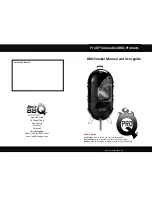
- 2 -
DFS8MS
– Installation instructions
Wireless smoke detector
English
Manually testing your smoke detector.
It is recommended the smoke detector be tested after installation, then at least once a
week to check the device is working properly. Press the "siren test/stop" button and
keep it pressed until an alarm is triggered and the red light starts flashing (see figure 4).
The siren will stop sounding once the button is released.
In the case of an interconnected configuration, when one of the DFS8MS detectors
enters test mode, all interconnected DFS8MS detectors also enter this mode.
WARNING 1: do not test with a flame. This may set the detector on fire and
damage your home. We recommend against testing with smoke because results
may be misleading, unless a special device is used.
WARNING 2: make sure you protect your ears during the test.
Test when installing detectors inter-connected by radio
1- Position the detectors at their planned installation site
2- Fold the antennae of each interconnected detector into two equal parts
3- Trigger a detector with the help of smoke or a smoke simulator, then check that once
the detector in question has activated its alarm function, all other interconnected
detectors also activate their alarm
4- Repeat this test for each inter-connected detector
5- Reposition the antennae in their initial position (unfolded)
The test is satisfactory if all attempts have led to the activation of the alarm of each
interconnected detector.
"Siren test/ stop" button to control your detectors
The DFS8MS detector is equipped with a "siren test/stop" button to help you control it.
•
To cancel an alarm, press the test button. The alarm will remain silent for about 10
minutes. The red light on the hood of the smoke alarm will flash every 10 seconds to show
that the unit has been muted. If, after 10 minutes, the DFS8MS continues to detect
smoke, it will trigger the alarm again.
In an interconnected configuration when one DFS8MS is muted after detecting smoke, all
DFS8MS are also muted. Conversely, pressing a test button of a DFS8MS which has not
detected smoke will not mute any of the DFS8MS. The DFS8MS whose red light is
flashing rapidly is that which has detected smoke.
Replacing the product
This product is powered by a sealed lithium battery that does not need replacing over its
recommended 10 year life span.
1. As part of regular maintenance, you should always check the device's replacement date.
After this date, the device must be replaced.
2. If the device has not been replaced by the due date, its battery will run out, triggering an
audio signal every 40 seconds indicating replacement is required.
3. When you replace a device, make sure the old one is recycled. Correct disposal or
recycling will avoid any damage to the environment or human health. When you dispose
of the product, make sure you separate it from other waste to ensure it will be recycled
ecologically and healthily.
Note: prolonged exposure to low or high temperatures or an excessive humidity rate
may reduce the life span of batteries. The life span of batteries will also be reduced in
the case of prolonged warning cycles.
Upkeep
Regularly clean the smoke detector head. Use a soft brush or the brush accessory of your
vacuum cleaner to remove dust and spiders webs from side openings through which the
smoke enters. To clean the hood wipe it with a damp cloth then dry it carefully.
The smoke chamber of the detector head performs a self-test every 40 seconds. If it is in
damaged condition, an audio alarm will sound every 32 seconds. In this case, clean the
smoke detector head as indicated above. If the problem persists, return the device.
Smoke detectors, particularly optical types (photoelectrical) are susceptible to the
penetration of dust and insects, which can trigger false alarms.
The manufacture of this product was undertaken using the most up to date designs
materials and techniques. It is nevertheless impossible to avoid completely the effects of
contamination by dust and insects. To extend the life span of the detector, you must
therefore ensure it is kept clean and prevent the accumulation of dust. Insects or spiders
webs found near the smoke detector should be rapidly removed.
In certain circumstances, even regular cleaning may not be sufficient to prevent
contaminants from accumulating in the smoke detection chamber, and triggering the alarm.
If this occurs, the smoke detector must be returned. Contamination is beyond our control, is
totally unforeseeable and should be considered as normal wear and tear. This is why it is
not covered by guarantee. Work caused as a result will be invoiced.
WARNING: do not paint the detector.
Finally, the device must be replaced after 10 years of use (check the "replacement date"
indicated on the side of the device)
Features
Radio-frequency range
1,000 m on open land
Battery
Lithium, sealed and with a life span equal to that of
the product
Service voltage
3 V
Battery life span (type)
Product life span: 10 years
Frequency
Narrow band, 868 MHz
Operating temperature
from 0° to +40°C
Siren output power
85 dB(A) at 3 m
Supervision
Yes
Detection
Optical smoke alarm
getconnected.honeywell.com
































